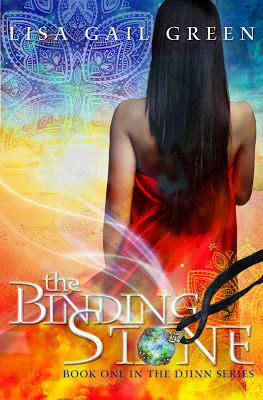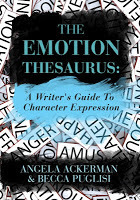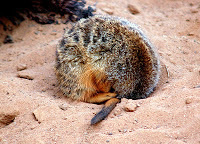Angela Ackerman's Blog: Writers Helping Writers, page 165
May 25, 2013
Physical Attributes Entry: Back
Physical description of a character can be difficult to convey—too much will slow the pace or feel 'list-like', while too little will not allow readers to form a clear mental image. If a reader cannot imagine what your character looks like, they may have trouble connecting with them on a personal level, or caring about their plight.
One way to balance the showing and telling of physical description is to showcase a few details that really help 'tell the story' about who your character is and what they've been through up to this point. Think about what makes them different and interesting. Can a unique feature, clothing choice or way they carry themselves help to hint at their personality? Also, consider how they move their body. Using movement will naturally show a character's physical characteristics, keep the pace flowing and help to convey their emotions.
BACK

Flickr: Creative Commons, Yuliya Libkina
Descriptors: wide, broad, muscular, bony, athletic, angular, stooped, slumped, curved, crooked, straight, hairy, strong, humped, tattooed
Key Emotions and How the Back is Involved:
Backs aren't noticed very much because they're always...well, in the back. But as a key part of the body, the back/spine is involved in many emotional responses. It will slump when a person feels sad, disappointed, or embarrassed. Alternatively, it straightens to show pride, confidence, defensiveness, or anger. Surprise or fear can cause the back to stiffen or freeze.
Simile and Metaphor Help:
She had a swimmer's back, broad enough to carry her own troubles and a few other's besides.
I hugged him tight and tried not to gasp. His back felt like a topographical map, the vertebrae a mountain range I could scale with my fingers.
Clichés to Avoid : a shiver running up the spine; a crooked spine that curves like an "s"; a ramrod straight spine
HINT: When describing any part of the body, try to use cues that show the reader more than just a physical description. Make your descriptions do double duty. Example: Miriam was stooped over almost double, eyes on the ground, her slippered feet feeling their way along the driveway. Getting from the front door to the mailbox was a real journey these days, and it made her back ache something awful. The new mailgirl had offered to bring Miriam's things to the porch, but...She smacked her lips and jabbed the concrete with her walking stick. If she couldn't make it to the mailbox and get her own bills, she might as well start picking out coffins.
BONUS TIP: The Colors, Textures & Shapes Thesaurus in our sidebar might help you find a fresh take on some of the descriptors listed above!
*****
AND...A NEWSFLASH!


Angela and I are THRILLED to announce that we've signed with a foreign rights agent! Marleen Seegers of 2 Seas Agency will be representing The Emotion Thesaurus internationally. We're super-excited to be working with Marleen, who has many years of international publishing experience and has been a joy to work with. Since we signed with her on Monday, Marleen has already received some interest from Korea, so we couldn't be happier!

One way to balance the showing and telling of physical description is to showcase a few details that really help 'tell the story' about who your character is and what they've been through up to this point. Think about what makes them different and interesting. Can a unique feature, clothing choice or way they carry themselves help to hint at their personality? Also, consider how they move their body. Using movement will naturally show a character's physical characteristics, keep the pace flowing and help to convey their emotions.
BACK

Flickr: Creative Commons, Yuliya Libkina
Descriptors: wide, broad, muscular, bony, athletic, angular, stooped, slumped, curved, crooked, straight, hairy, strong, humped, tattooed
Key Emotions and How the Back is Involved:
Backs aren't noticed very much because they're always...well, in the back. But as a key part of the body, the back/spine is involved in many emotional responses. It will slump when a person feels sad, disappointed, or embarrassed. Alternatively, it straightens to show pride, confidence, defensiveness, or anger. Surprise or fear can cause the back to stiffen or freeze.
Simile and Metaphor Help:
She had a swimmer's back, broad enough to carry her own troubles and a few other's besides.
I hugged him tight and tried not to gasp. His back felt like a topographical map, the vertebrae a mountain range I could scale with my fingers.
Clichés to Avoid : a shiver running up the spine; a crooked spine that curves like an "s"; a ramrod straight spine
HINT: When describing any part of the body, try to use cues that show the reader more than just a physical description. Make your descriptions do double duty. Example: Miriam was stooped over almost double, eyes on the ground, her slippered feet feeling their way along the driveway. Getting from the front door to the mailbox was a real journey these days, and it made her back ache something awful. The new mailgirl had offered to bring Miriam's things to the porch, but...She smacked her lips and jabbed the concrete with her walking stick. If she couldn't make it to the mailbox and get her own bills, she might as well start picking out coffins.
BONUS TIP: The Colors, Textures & Shapes Thesaurus in our sidebar might help you find a fresh take on some of the descriptors listed above!
*****
AND...A NEWSFLASH!


Angela and I are THRILLED to announce that we've signed with a foreign rights agent! Marleen Seegers of 2 Seas Agency will be representing The Emotion Thesaurus internationally. We're super-excited to be working with Marleen, who has many years of international publishing experience and has been a joy to work with. Since we signed with her on Monday, Marleen has already received some interest from Korea, so we couldn't be happier!

Published on May 25, 2013 01:00
May 24, 2013
Turning Story Opening Don'ts Into Do's

Today I'm super happy to have author & friend Lisa Gail Green in for a visit. Lisa is the author of The Binding Stone (The Djinn Series). She's looking at problem story openings and offering ideas on how to make these work, so please read on!
~ * ~
We’ve all heard the tips on what NOT to do in an opening. But I can boil it down to one key word for what you DO want.
Balance.
That’s right. Let’s take a closer look so I can explain.
What NOT to do:
• Start in the middle of a huge action sequence. Why not? Two questions:
Where do you go from there? And why should I care?
• Start with paragraphs of lovely description. ZZZZZZZZZ. I want to meet your character and know what their problem is!
• Start with waking up or a dream. I don’t know why – maybe because that seems like a natural place to start if we don’t know the real start – but everyone does it.
• Exposition. Back story is a tool you’re using as an author to get your head on straight. But you have to find a way to tell the story that’s happening in your book, not the one that happened to get there. Again, I want to know who your character is and what their problem is.
Now. Insert some balance and let’s see what happens.
ACTION: If you want to start with action, you’re probably a plot type person. Go ahead! You do need to SHOW your MC in an interesting situation (notice I didn’t say dangerous, just interesting) where their own personality shines through. Thus the balance. Pick something that showcases their unique voice. Show them doing something that’s different than what most others would do in the same situation.
DESCRIPTION: If you like description, chances are you are a world builder. That’s awesome! But make sure to show your world through your MC’s eyes and use it to highlight whatever is going on. Again, deliver description by filtering it through the
character's eyes, showing the world as they see it, not how others might.
WAKING & DREAMING: If you start with waking up, ask: must I? The truth is I HAVE. In my short story, BLACKOUT, for example I DO start with my MC waking up (naked in the backyard with ravens circling above and a creepy neighbor next door.) In other words, it’s okay to break rules, but only if you understand why they’re there in the first place and have a good reason. My reason? I wanted to show that her actions set her apart from what other people might do the same scenario.
EXPOSITION: Now that’s tough. You have know whether it’s absolutely necessary. It certainly doesn’t belong in the beginning though. The start should indicate who your character is and at least hint at what issue they will face. Right now. In THIS story. Whatever they are doing or thinking, it should be unique and relevant to the here and now.
 Balance is the key to a great book and a great beginning. World, plot, and character should combine to immerse the reader right away and make them care. What’s one way to do that? Say it with me… Show the MC doing something or thinking something that’s different than what most people would do in the same situation!
Balance is the key to a great book and a great beginning. World, plot, and character should combine to immerse the reader right away and make them care. What’s one way to do that? Say it with me… Show the MC doing something or thinking something that’s different than what most people would do in the same situation! ~ * ~
And now I get to show off Lisa's wonderful book cover and blurb:
Tricked into slavery by the man she loved, the Djinni Leela has an eternity to regret her choices.
Awakened in the prison of her adolescent body, she finds a new master in possession of the opal that binds her. But seventeen-year-old Jered is unlike any she’s seen. His kindness makes Leela yearn to trust again, to allow herself a glimmer of hope.
Could Jered be strong enough to free her from the curse of the Binding Stone?
Sounds pretty awesome, doesn't it? I love the gender swap on the traditional Genie story. If you like, you can add this book to your Goodreads List, of find out more on this series by visiting Lisa on Facebook, Twitter or her home stomping grounds, Paranormal Point Of View! Oh, AND I just grabbed this book myself. It's on sale today: .99 cents at Amazon.

Published on May 24, 2013 04:00
May 22, 2013
Death by Comparison

I’m kind of a classic rock geek aficionado, so one of my favorite shows is VH1’s Behind The Music. I think I’ve seen every episode. I remember one a long time ago about Dokken—which may prompt many of you to say Who? I love Dokken. They figure largely into my playlist. Musically, I think they had more to offer than the typical hair band, but they failed to capitalize on that strength. Lead singer Don Dokken claims it’s because they were always comparing themselves to the bigger bands and trying to recreate those successes. Case in point: if Mötley Crüe went through two boxes of Aqua Net a week, then Dokken clearly couldn’t be successful with only one. (Personally, if I was trying to compete with Crüe, I’d be less concerned with hair spray and more worried about Tommy Lee’s revolving drum set. But that’s just me.)
Dokken was so focused on emulating the successful bands that they lost sight of their own individuality and the strengths that could have set them apart. As a result, when I say Dokken you say Who? They actually did pretty well in the 80s but fell short of what they potentially could have become.
And this made me wonder: how many writers also fall short of their dreams because they’re stuck in the comparison trap?
Personally, I struggle with this. I see that Nora Roberts is releasing FIVE new novels in 2013 and, after retrieving my jaw from the floor, I get a little bummed because I know I’ll never be that prolific. When Kristen Lamb’s blog posts pop into my inbox five days a week, I find myself wishing I could come up with such practical content day after day. Closer to home, there’s my über-talented co-blogger and co-author, Angela Ackerman—the Obi Wan to my Luke. I’m constantly blown away by the marketing plans she comes up with. Her brain is like Hermione’s magically-expanding purse, popping out one brilliant idea after another.
Studying our writing mentors and learning from them is healthy and smart and generally a good idea. But that’s not what’s happening with the wistful comparisons mentioned above. Thoughts like these are based in negativity, focusing on what we can’t do rather than on what we can. They make us feel badly about ourselves, which decreases creativity and efficiency and actually increases our chances of failure.
So how do we admire the greats without getting sucked into the comparison trap?

Know your strengths . My husband is one of those people whose positive traits are kind of glaring. They’re just very obvious. I’m not like that; my strengths are quieter. After a number of years of
marriage, I kind of lost track of what I contributed, what I was good at. So I made a list. I wrote down all of my strengths—as a mom, a writer, a person, everything. Then I asked people who knew me to add to it. The list has changed somewhat over the years, with the move from teaching to writing, and now that I’m a mom. But I refer to my list often. Not only does it make me feel good about myself, but it reminds me of who I am. As a writer, it keeps me focused on the positive instead of the negative.
Capitalize on your strengths . Once you know where you’re strong, focus your time and energy on those areas. This sounds counterintuitive, I know. I mean, shouldn’t we focus on our areas of weakness, since this is where we need to improve? I don’t think so. Yes, we absolutely need to work on our weaknesses, but we should spend as much time, if not more, focusing on our strengths. Why? Because we’re passionate about them. We’re most productive when doing them. We excel because of them. Here’s a personal example: I’m not so great at social networking. While I have plans to improve in this area, I’m not going to focus the majority of my time there because I’m never going to be great at it. Instead, I’m focusing on writing. When it comes to craft, I’m pretty solid, but my storytelling needs work. Since this is part of writing well, I’m excited to learn and grow in this area. As I improve, I’ll become more proficient, more efficient, more prolific. And it won’t be this huge struggle that comes from focusing on something I hate to do and I’m not any good at.
Be realistic . I can’t churn out a flawless novel every six months. I can’t put in the hour-a-day social networking effort it would take to crank up my online presence. Some authors can easily achieve these goals, but not me. That’s why we call them personal goals. Don’t look at what other people are doing and assume that success must be achieved by following the same formula. Make goals that work for you, according to your daily schedule, your time constraints, your strengths and desires. Set reasonable goals for yourself and when you reach them, be proud of your accomplishments, knowing you’ve done as much as you can with the time and the talents you’ve been given.
Comparisons can be helpful as a means of seeing new possibilities, but very quickly they become counter-productive. Don’t chase the Crües of the writing world. Acknowledge your weaknesses and embrace your strengths. Utilize your unique combination of talents to achieve your own brand of success, and you’ll get there eventually.
HEADS UP! If you liked Angela's post on Cultivating Reader Interest through Unexpected Emotion from her recent Donald Maass Workshop, she's sharing another lesson learned over at Rebekah Grow's blog. This one's on Introspection & The Character's Black Moment. Just follow the link!

Published on May 22, 2013 03:00
May 17, 2013
Physical Attribute Entry: Chest
Physical description of a character can be difficult to
convey—too much will slow the pace or feel 'list-like', while too
little will not allow readers to form a clear mental image. If a reader
cannot imagine what your character looks like, they may have trouble
connecting with them on a personal level, or caring about their plight.
One
way to balance the showing and telling of physical description is to
showcase a few details that really help 'tell the story' about who your
character is and what they've been through up to this point. Think about
what makes them different and interesting. Can a unique feature,
clothing choice or way they carry themselves help to hint at their
personality? Also, consider how they move their body. Using movement
will naturally show a character's physical characteristics, keep the
pace flowing and help to convey their emotions.
CHEST AREA

photo credit: lta362 via photopin cc
Descriptors:
MEN (CHEST): brawny, smooth, hairy, firm, curly, broad, narrow, warm, sculpted, hard, strong, well-defined, chiseled, toned, pecs, pectorals, heavy, sagging, deep, flabby, bumpy, thick, skinny, bony, concave, sweaty, gleaming, solid, muscular, lean, tanned, tattooed, scrawny, athletic, spindly, thin, bulging, scarred, nipples, nips, narrow, defined, pale, taut, hardened
WOMEN (BREASTS): busty, big-chested, full, flat, sagging, well-endowed, buxom, busty, stacked, built, curvy or curvaceous, heavy, slopes, rounded, shapely, petite, cleavage, tanned, voluptuous, bouncing, jiggling, small-breasted, peaks, mountains, mounds, valley cleavage, soft, silky, smooth, alabaster, tanned, bronzed, droopy, low, high, perky, pillows, overflowing, straining, ample, thin, boobs, ta-tas
Things Breasts/Chests Do:
Thrust: chests and breasts are a sexual area that is closely tied into a person's self esteem and instinctive, primal response. Baring a chest or thrusting it out is either a sexual display, an action to show strength and confidence, and (especially in males) a way to show aggression if feeling threatened.
Feed: This one's just for the ladies of course, but breast feeding is the function of breasts.
Key Emotions:
Desire: Touching and caressing the chest or breasts between compatible, romantic pairs is a way to show affection and amp up sexual desire. Women and men find this attribute an attractive feature in others that match their sexual preferences, and even if one is in a committed relationship with someone else, looking (without being creepy or pervy about it) and appreciating this attribute is healthy and normal.
Surprise/Shock: If a person is surprised, it is normal for their hand to fly to their chest in automatic response.
Confidence/Pride: Both women and men thrust their chests out slightly when feeling energized by confidence or pride.
Anger/Rage/Hatred: These negative emotions bring out the 'Fight' in fight or flight, and the instinctive response is to make oneself look bigger and more imposing. Both men and women will thrust out their chests when threatened.
Simile and Metaphor Help:
Linda gasped, her breasts lifting up in her tube top like oranges ready to spill from a fruit basket.
Alex's chest was hard and lean, muscular without being overdone. I ran my hands over the plains of his skin, my light touch a wind brushing the Sahara.
Clichés to Avoid :
describing a woman's breasts as beach balls, balloons, etc.
breasts that 'heave'
A chest that is 'as hard as a rock'
BONUS TIP: The
Colors, Textures & Shapes Thesaurus in our sidebar might help
you find a fresh take on some of the descriptors listed above!

Published on May 17, 2013 03:30
May 15, 2013
Donald Maass Wisdom: Cultivate Reader Interest Through Unexpected Emotions
Recently I was at a workshop with Donald Maass and the topic of Emotional Writing came up. As you can imagine, I immediately perked up and my fingers became cyclones over the keyboard of my iPad, taking notes.

photo credit: Send me adrift. via photopin cc
The gist of it was this: the most powerful stories have emotional writing, the kind where we dig deep into our own feelings and then put them on the page. Donald encouraged us to move past ‘expected’ character emotions and try for something deeper, more primal. Something unexpected.
We were to take a scene from our book, list the primary emotion our character was feeling, and then change it to something they would never dare to voice or show, but felt none-the-less.
I chose a scene from my Upper MG WIP, Wrath of a God. The Egyptian God Osiris, newly resurrected and clothed as a simple human storekeeper, shows up at the protagonist’s house as a surprise dinner guest. The goal is to intimidate my hero, Brett, and convince him to stop fighting Osiris as he attempts to gain control over everyone in the town. The two of them are speaking outside, away from Brett’s mother who doesn’t know who Osiris really is. Brett is full of anger and frustration because deep down, he knows he’s powerless to stop the God.
But a deeper emotion, something unexpected? What might he also feel? I decided to try DESIRE.
Donald then told us to then duct tape our protagonist, and show that emotion non-verbally (talk about right up my alley!) Want to see what I came up with? (WARNING: It’s not exceptionally written--just a two minute free write!)
A glow came off of Osiris, a hue that had nothing to do with the sun setting. It was something that came from inside the god...a sureness, a confidence. He was powerful, close to having it all. Brett imagined that for a moment, imagined the feeling of control, the ability to wipe the slate clean. To heal his mother, to heal the town.
His chest expanded and he straightened with the need to have what Osiris had, to shape the world with power.
But as he stared at the god, the shadows clutching the sharp angles of his face stood out in dark contrast. Power corrupted. Power consumed. If Brett had it, would he do good? Or would he become like Osiris, and only want more? A deep pain spread in his chest and he reached up, kneading it with his palm. This was wrong. How could he feel this, want this?

I love what I came up with, because it’s so much deeper than the original emotions of anger and frustration. By honing in on Brett’s desire, I show how he craves what he doesn’t have (power & control), and then the shame he feels at wanting to be like the antagonist.
Donald then challenged us to find 20 more scenes and do this very same thing. And you know what? I plan to. (Oh and that little book on the right? Click on it. You want to own it, trust me--it's fabulous!)
How about you? Have you ever used an unexpected emotional reaction to deepen your character to readers? Let me know in the comments!


photo credit: Send me adrift. via photopin cc
The gist of it was this: the most powerful stories have emotional writing, the kind where we dig deep into our own feelings and then put them on the page. Donald encouraged us to move past ‘expected’ character emotions and try for something deeper, more primal. Something unexpected.
We were to take a scene from our book, list the primary emotion our character was feeling, and then change it to something they would never dare to voice or show, but felt none-the-less.
I chose a scene from my Upper MG WIP, Wrath of a God. The Egyptian God Osiris, newly resurrected and clothed as a simple human storekeeper, shows up at the protagonist’s house as a surprise dinner guest. The goal is to intimidate my hero, Brett, and convince him to stop fighting Osiris as he attempts to gain control over everyone in the town. The two of them are speaking outside, away from Brett’s mother who doesn’t know who Osiris really is. Brett is full of anger and frustration because deep down, he knows he’s powerless to stop the God.
But a deeper emotion, something unexpected? What might he also feel? I decided to try DESIRE.
Donald then told us to then duct tape our protagonist, and show that emotion non-verbally (talk about right up my alley!) Want to see what I came up with? (WARNING: It’s not exceptionally written--just a two minute free write!)
A glow came off of Osiris, a hue that had nothing to do with the sun setting. It was something that came from inside the god...a sureness, a confidence. He was powerful, close to having it all. Brett imagined that for a moment, imagined the feeling of control, the ability to wipe the slate clean. To heal his mother, to heal the town.
His chest expanded and he straightened with the need to have what Osiris had, to shape the world with power.
But as he stared at the god, the shadows clutching the sharp angles of his face stood out in dark contrast. Power corrupted. Power consumed. If Brett had it, would he do good? Or would he become like Osiris, and only want more? A deep pain spread in his chest and he reached up, kneading it with his palm. This was wrong. How could he feel this, want this?

I love what I came up with, because it’s so much deeper than the original emotions of anger and frustration. By honing in on Brett’s desire, I show how he craves what he doesn’t have (power & control), and then the shame he feels at wanting to be like the antagonist.
Donald then challenged us to find 20 more scenes and do this very same thing. And you know what? I plan to. (Oh and that little book on the right? Click on it. You want to own it, trust me--it's fabulous!)
How about you? Have you ever used an unexpected emotional reaction to deepen your character to readers? Let me know in the comments!

Published on May 15, 2013 03:30
May 13, 2013
Using Nonverbal Communication to Wow Readers WEBINAR
Hi everyone!
I just wanted to post a reminder about our webinar tomorrow at WANA International. This is a great opportunity to talk show about one of the biggest problems writers face: showing character emotion.
Here's more info below, along with the REGISTRATION LINK. Hope to see you there!
Using Nonverbal Communication to Wow Readers
Instructors: Angela Ackerman and Becca Puglisi
Email: jaddpublishing@gmail.com
Date: May 14th, 2013, 8:00 pm - 9:30 pm EST
Description:
Readers read to have an emotional experience, to feel what’s happening on the page. With the vast competition in publishing today, it’s more important than ever for authors to hook readers through strong emotional connections. One of the best ways to make this happen is by clearly conveying the character’s emotion through a variety of techniques.

This 90-minute course will teach you the effectiveness of showing (rather than telling) your character’s emotion. You will learn how to build reader empathy by showing emotion through dialogue, thoughts, body language, and visceral reactions. Also covered are common problem areas, such as melodrama and clichés, and how to avoid them.
Special Notes: This course for writers of all genres will include a presentation and Q&A session. Each attendee will also receive a PDF version of The Emotion Thesaurus: A Guide to Character Expression, to aid them in their writing efforts. If the attendee already has this resource, they can have their copy gifted to a friend!
There are loads of great classes at WANA International, so feel free to swing by and have a look!
I just wanted to post a reminder about our webinar tomorrow at WANA International. This is a great opportunity to talk show about one of the biggest problems writers face: showing character emotion.
Here's more info below, along with the REGISTRATION LINK. Hope to see you there!
Using Nonverbal Communication to Wow Readers
Instructors: Angela Ackerman and Becca Puglisi
Email: jaddpublishing@gmail.com
Date: May 14th, 2013, 8:00 pm - 9:30 pm EST
Description:
Readers read to have an emotional experience, to feel what’s happening on the page. With the vast competition in publishing today, it’s more important than ever for authors to hook readers through strong emotional connections. One of the best ways to make this happen is by clearly conveying the character’s emotion through a variety of techniques.

This 90-minute course will teach you the effectiveness of showing (rather than telling) your character’s emotion. You will learn how to build reader empathy by showing emotion through dialogue, thoughts, body language, and visceral reactions. Also covered are common problem areas, such as melodrama and clichés, and how to avoid them.
Special Notes: This course for writers of all genres will include a presentation and Q&A session. Each attendee will also receive a PDF version of The Emotion Thesaurus: A Guide to Character Expression, to aid them in their writing efforts. If the attendee already has this resource, they can have their copy gifted to a friend!
There are loads of great classes at WANA International, so feel free to swing by and have a look!

Published on May 13, 2013 12:01
May 11, 2013
Physical Attributes Entry: Butts
Physical description of a character can be difficult to convey—too much will slow the pace or feel 'list-like', while too little will not allow readers to form a clear mental image. If a reader cannot imagine what your character looks like, they may have trouble connecting with them on a personal level, or caring about their plight.
One way to balance the showing and telling of physical description is to showcase a few details that really help 'tell the story' about who your character is and what they've been through up to this point. Think about what makes them different and interesting. Can a unique feature, clothing choice or way they carry themselves help to hint at their personality? Also, consider how they move their body. Using movement will naturally show a character's physical characteristics, keep the pace flowing and help to convey their emotions.
BUTTS
Descriptors: round, flat, huge, tiny, muscular, fat, bony, lumpy, curvy, cute, hard, tight, dimpled, hairy, pimpled, smooth, fleshy, jiggly, bouncy, firm, doughy
Synonyms: rump, bottom, rear end, ass, backside, trunk, bum, derriére, fanny, gluteous maximus, posterior, tush, buttocks, cheeks, tail, keister, behind, hiney, caboose, arse
Famous References from Pop Culture:
Kim Kardashian
Baby Got Back (Sir Mix-a-Lot)
Beyoncé
Jennifer Lopez
Simile and Metaphor Help:
He was a definite hard body. I'm pretty sure if I flicked his ass, it would ring like a bell.
I swung my legs out of bed and stifled a shriek. Gingerly, I poked at the wooden slabs that used to be my glutes. Must've overdone it with the lunges yesterday.
Clichés to Avoid : smooth as a baby's bottom; butts so big you could show a movie on them; doing a job half-assed; rigid or stuck-up people described as having a pole up their ass
HINT: When describing any part of the body, try to use cues that show the reader more than just a physical description. Make your descriptions do double duty. Example: I sat carefully on the plastic chair. It creaked but held my weight as my rear end oozed over the sides like batter in a waffle iron. Someone groaned behind me. Then a snicker. I opened my history book and pretended to read.
BONUS TIP: The Colors, Textures & Shapes Thesaurus in our sidebar might help you find a fresh take on some of the descriptors listed above!
And here's one for all of us who were alive in the 80s:

Published on May 11, 2013 00:30
May 8, 2013
Hiding Emotions: Just Act Normal
As humans, we value honesty and strive to be as truthful as we can as often as we can. But in truth, protection is also important to our species, and many times it trumps honesty. To protect ourselves, everyone periodically resorts to deception—to avoid consequences, to get what we want, to keep from hurting ourselves or others.
One of the most common deceptions I see has to do with our emotions. We mislead others to think we’re feeling one way when we’re really feeling something else. Why? To avoid questions we don’t want to answer, to deny our true feelings and avoid having to face them, to save face in front of others, to keep a secret...the possibilities are endless.
Whatever the motivation, we hide our emotions all the time. And this means that our characters should, too. As authors, we need to know how to show this evasiveness in regards to what our characters are feeling.

*The Head-in-Sand technique. Effective, but...not ideal*
One of the most common methods for hiding one’s emotions is the Just Act Normal technique. This is when a character disguises their internal feelings by acting like everything’s fine. This is tough to write, because you’ve essentially got to show two things at once. Here’s a good example of this technique from The Outlaws of Sherwood, by Robin McKinley:
“A wrestler should be a little slippery.” Little John handed Cecily the pot of tallow.
She took it from him daintily, her fingertips not touching his hand, and began to use the palms of her hands, rubbing the long round muscles in a circular motion, using the heels of her hands around the shoulder blades, running the edge of her palm down the spine. She was not so young that she did not know what was happening to her: why her heart was beating too fast, why her breath came hard. She knew, and tried to pretend she was Little John’s sister, and failed.
“That should do,” she said, after a few of the simultaneously longest and shortest minutes of her life. She absent-mindedly went to rub her sticky hands down the front of her bright new tunic when there was an exclamation from her companion and her arms were nearly jerked out of their sockets as Little John grabbed her wrists.
“Not on the tunic! Have you no sense?”
He rubbed each of her hands down each of his forearms and she closed her eyes and thought about fraternal relationships.
Little John said, “Here—are you all right? I am sorry, did I hurt you?”
“Not nearly as much as all the bruises from my quarterstaff lessons, my friend,” she said with a fair imitation of her usual tone.
This exchange clearly shows Cecily’s true emotion (desire) and her attempt to act normal. Her desire is shown through a number of indicators: in the detailed way that she completes the simple act of applying tallow to Little John’s skin; through her thoughts, which are private and safe; by evading his are you all right question; and through her internal cues, which are also safe. All of these clues—none of which Little John can see—indicate how she really feels. In contrast, her words remain nonchalant, showing him what she wants to convey: normalcy.
When hiding an emotion, it’s easier to lie with our words than with our bodies. This is why we turn away when we don’t want people to see what we’re feeling—to give us time to get our bodies under control while we’re saying, “I’m fine. Everything’s fine.” So when your character needs to hide, try this formula:
Show the true emotion through vehicles that are difficult for others to notice, like internal physical cues and thoughts. Use details, words, and comparisons that indicate whatever emotion your character is truly feeling. Show the false emotion through dialogue and forced body cues that are meant to deceive others: controlling one's tone of voice, rearranging one’s facial expression, trying to mimic “normal” gestures, etc.

image courtesy of Lisa Hall-Wilson
Emotions are multi-faceted and tricky, but we’ve got to learn to write them clearly if we want to create believable, empathetic characters. To help with conveying emotion effectively, Angela and I are teaching a WANA course next week on Using Nonverbal Communication to Wow Readers. It’s a 90-minute course that you can take from the comfort of your own home, in your pajamas, with the fruity beverage of your choice. So if you’re looking for ways to beef up your character’s emotions, you can register by clicking the link above. We’d love to see you there!
*photo credit: Jenny Rollo @ stock.xchange
One of the most common deceptions I see has to do with our emotions. We mislead others to think we’re feeling one way when we’re really feeling something else. Why? To avoid questions we don’t want to answer, to deny our true feelings and avoid having to face them, to save face in front of others, to keep a secret...the possibilities are endless.
Whatever the motivation, we hide our emotions all the time. And this means that our characters should, too. As authors, we need to know how to show this evasiveness in regards to what our characters are feeling.

*The Head-in-Sand technique. Effective, but...not ideal*
One of the most common methods for hiding one’s emotions is the Just Act Normal technique. This is when a character disguises their internal feelings by acting like everything’s fine. This is tough to write, because you’ve essentially got to show two things at once. Here’s a good example of this technique from The Outlaws of Sherwood, by Robin McKinley:
“A wrestler should be a little slippery.” Little John handed Cecily the pot of tallow.
She took it from him daintily, her fingertips not touching his hand, and began to use the palms of her hands, rubbing the long round muscles in a circular motion, using the heels of her hands around the shoulder blades, running the edge of her palm down the spine. She was not so young that she did not know what was happening to her: why her heart was beating too fast, why her breath came hard. She knew, and tried to pretend she was Little John’s sister, and failed.
“That should do,” she said, after a few of the simultaneously longest and shortest minutes of her life. She absent-mindedly went to rub her sticky hands down the front of her bright new tunic when there was an exclamation from her companion and her arms were nearly jerked out of their sockets as Little John grabbed her wrists.
“Not on the tunic! Have you no sense?”
He rubbed each of her hands down each of his forearms and she closed her eyes and thought about fraternal relationships.
Little John said, “Here—are you all right? I am sorry, did I hurt you?”
“Not nearly as much as all the bruises from my quarterstaff lessons, my friend,” she said with a fair imitation of her usual tone.
This exchange clearly shows Cecily’s true emotion (desire) and her attempt to act normal. Her desire is shown through a number of indicators: in the detailed way that she completes the simple act of applying tallow to Little John’s skin; through her thoughts, which are private and safe; by evading his are you all right question; and through her internal cues, which are also safe. All of these clues—none of which Little John can see—indicate how she really feels. In contrast, her words remain nonchalant, showing him what she wants to convey: normalcy.
When hiding an emotion, it’s easier to lie with our words than with our bodies. This is why we turn away when we don’t want people to see what we’re feeling—to give us time to get our bodies under control while we’re saying, “I’m fine. Everything’s fine.” So when your character needs to hide, try this formula:
Show the true emotion through vehicles that are difficult for others to notice, like internal physical cues and thoughts. Use details, words, and comparisons that indicate whatever emotion your character is truly feeling. Show the false emotion through dialogue and forced body cues that are meant to deceive others: controlling one's tone of voice, rearranging one’s facial expression, trying to mimic “normal” gestures, etc.

image courtesy of Lisa Hall-Wilson
Emotions are multi-faceted and tricky, but we’ve got to learn to write them clearly if we want to create believable, empathetic characters. To help with conveying emotion effectively, Angela and I are teaching a WANA course next week on Using Nonverbal Communication to Wow Readers. It’s a 90-minute course that you can take from the comfort of your own home, in your pajamas, with the fruity beverage of your choice. So if you’re looking for ways to beef up your character’s emotions, you can register by clicking the link above. We’d love to see you there!
*photo credit: Jenny Rollo @ stock.xchange

Published on May 08, 2013 00:30
May 2, 2013
A Short Anecdote, and How to Build Reader Empathy Early On in your Story
Hey there, people!
We all know that Angela recently took a once-in-a-lifetime vacation to Asia. This has made me just a teensy bit jealous. But I'm comforted by the fact that I'll be riding the Small World ride today, which technically means I'll be visiting, like, 40 countries. IN ONE DAY. Quite a feat, but anything's possible at the most magical place on Earth. And since Angela had some interesting info to share from her trip, I thought I'd share an "international" story of my own.

Before the Incident
A few years ago on a trip to Disney, we waited twenty minutes in the Small World line, boarded our boat, and had just started the ride when my recently-potty-trained daughter uttered those four words no mother on a Disney ride wants to hear: "I have to pee."
I spent the first ten minutes of the ride trying to distract her from the growing pressure in her bladder, but we all know how futile this is. Then she said something even more terrifying. "I have to poo."
It was at that point that my daughter and I abandoned our boat and took a quick trip through Mexico to the nearest Salida de Emergencia. You know the signs they put on those doors that say Alarm Will Sound? They lie. No alarm went off. What DOES happen (as I found out later from my husband, who was stuck in the boat with my son) is they stop the ride for approximately fifteen minutes until they can be sure that it was just a mom and child exiting the ride and not someone carrying explosives of the less stinky kind. I'm not sure who hated me more at that moment, the Disney employees required to follow protocol for this eventuality, or the people stuck in the boats while It's a world of laughter, a world of tears played on, and on, and on...

Cute giraffes, or hidden camera receptacles?
I'm a little worried to return to Small World. I'm afraid our pictures might be posted on WANTED signs in 47 different languages. We shall see. Either way, the Disney machine seems to have been prophetic with its marketing slogan for the year, which is posted on signs all over the park: Let the Memories Begin!
Hopefully, today's trip will be less memorable. In the meantime, the lovely people over at the Helium.com blog (who should in no way be associated with any part of the aforementioned anecdote) have agreed to host me. I'll be sharing some thoughts on how to create reader empathy early on in your story, and the Helium blog as a whole has a lot of helpful info to offer. If you've got time, please stop by and say Hola.

We all know that Angela recently took a once-in-a-lifetime vacation to Asia. This has made me just a teensy bit jealous. But I'm comforted by the fact that I'll be riding the Small World ride today, which technically means I'll be visiting, like, 40 countries. IN ONE DAY. Quite a feat, but anything's possible at the most magical place on Earth. And since Angela had some interesting info to share from her trip, I thought I'd share an "international" story of my own.

Before the Incident
A few years ago on a trip to Disney, we waited twenty minutes in the Small World line, boarded our boat, and had just started the ride when my recently-potty-trained daughter uttered those four words no mother on a Disney ride wants to hear: "I have to pee."
I spent the first ten minutes of the ride trying to distract her from the growing pressure in her bladder, but we all know how futile this is. Then she said something even more terrifying. "I have to poo."
It was at that point that my daughter and I abandoned our boat and took a quick trip through Mexico to the nearest Salida de Emergencia. You know the signs they put on those doors that say Alarm Will Sound? They lie. No alarm went off. What DOES happen (as I found out later from my husband, who was stuck in the boat with my son) is they stop the ride for approximately fifteen minutes until they can be sure that it was just a mom and child exiting the ride and not someone carrying explosives of the less stinky kind. I'm not sure who hated me more at that moment, the Disney employees required to follow protocol for this eventuality, or the people stuck in the boats while It's a world of laughter, a world of tears played on, and on, and on...

Cute giraffes, or hidden camera receptacles?
I'm a little worried to return to Small World. I'm afraid our pictures might be posted on WANTED signs in 47 different languages. We shall see. Either way, the Disney machine seems to have been prophetic with its marketing slogan for the year, which is posted on signs all over the park: Let the Memories Begin!
Hopefully, today's trip will be less memorable. In the meantime, the lovely people over at the Helium.com blog (who should in no way be associated with any part of the aforementioned anecdote) have agreed to host me. I'll be sharing some thoughts on how to create reader empathy early on in your story, and the Helium blog as a whole has a lot of helpful info to offer. If you've got time, please stop by and say Hola.

Published on May 02, 2013 21:00
April 27, 2013
A Big Thank You & Today's Physical Attributes Entry
Before I get into today's thesaurus entry, Becca and I want to give out a big shout out to Kristin Lenz at YA Fusion. She wrote a review of The Emotion Thesaurus: A Writer's Guide To Character Expression, and it was accepted into the SCBWI Bulletin! (I know--how amazing, right?)

Thank you, Kristin!
We are ever so grateful to her for being a champion of our book and seeking out this magazine to place her review! I recently posted on The Importance of Reviews, and her kindness will result in even more writers discovering our resource, so we are just blown over by this.
Unfortunately, the Bulletin credited the review to another author, and while they are going to change it for the digital copy I believe, the print copy is too late to change. I feel bad because it's very thorough and well done, and she deserves to have her name on it, so PLEASE HELP US in thanking her by stopping in at YA Fusion blog and say hello! They are a great group over there, with inspiring and helpful content for all writers.
***

Bradley Cooper (you are welcome, Ladies!)
Physical description of a character can be difficult to
convey—too much will slow the pace or feel 'list-like', while too
little will not allow readers to form a clear mental image. If a reader
cannot imagine what your character looks like, they may have trouble
connecting with them on a personal level, or caring about their plight.
One
way to balance the showing and telling of physical description is to
showcase a few details that really help 'tell the story' about who your
character is and what they've been through up to this point. Think about
what makes them different and interesting. Can a unique feature,
clothing choice or way they carry themselves help to hint at their
personality? Also, consider how they move their body. Using movement
will naturally show a character's physical characteristics, keep the
pace flowing and help to convey their emotions.
FACIAL HAIR
Descriptors : groomed, clean, trimmed, wiry, patchy, sleek, oiled, bristle, stubble, scruffy, scraggly, neat, shaped, bushy, narrow, thin, thick, curly, long, short, smudge, shadow, kinky, dark, salty, wild, bearded, mustache, muttonchops, goatee, sideburns, beards, whiskers
Here's a list of different styles of facial hair!
Things Facial Hair Do:
Tickle: in close contact, facial hair can feel ticklish!
Rub: facial hair can also be unpleasant--rubbing, scratching and aggravating sensitive skin.
Itch: facial hair can be quite itchy for the owner, especially in hot or humid climates. Some men grow beards during the cold months and shave during the summer.
Key Emotions and How Related Facial Hair Relates:
Adoration & Love: Some find facial hair extremely attractive, and like a man who can grow a good beard or mustache. Stubble is a trend that has gain a lot of traction. However, with that growth comes some sensibility and good grooming expectations. Gone are the days of waxed and curled mustaches, and no one likes to see one's lunch hangout out of one's beard.
Pride & Satisfaction: Many men see growing facial hair as a sign of manliness. The thickness of one's beard, or the overall even stubble is a source of pride among males. Men like to touch, pull, tweak, rub, stroke and smooth their facial hair.
Embarrassment: Most women are not fans of facial hair on themselves, and they will eradicate any facial hair that is not invisible against one's completion by tweezing, waxing or shaving. Men who feel unsuccessful at growing hair (when it comes in it's patchy, uneven or just not flattering to one's facial structure) simply choose to shave.
Simile and Metaphor Help:
Johnny always takes things too far. Growing a Movember mustache in November to support Cancer Awareness is one thing, but now it's April, and robins are ready to settle in to raise a family.
When my nephew Rick asked what I thought of his 'mustache' I didn't have the heart to tell him it looked like whiskers on a hairless cat.
Clichés to Avoid : Five o'clock shadow (it's been done to death); the Pornstashe, comparing a beard to Santa's beard or a biker's beard; the handlebar mustache; calling a 'stache or beard a soup strainer
HINT: When
describing any part of the body, try to use cues that show the reader
more than just a physical description. Make your descriptions do double
duty. Example:
Mom strutted past the security checkpoint, her perfectly made up face surly and grim. As soon as she reached us, she began complaining in Italian about the flight--the food was cold, the seat too small, someone had gas and the man next to her grumbled every time she got up to use the washroom. As she blamed us for picking the flight, railing on how the air conditioning ruined her freshly cut hairdo, I took the greatest satisfaction in the wiry tangle of white sprouting out of a mole on her chin. Mom, always immaculately dressed, always primped and perfect...missed a spot.
BONUS TIP: The
Colors, Textures & Shapes Thesaurus in our sidebar might help
you find a fresh take on some of the descriptors listed above!
Bradley Cooper photo credit: david_shankbone via photopin cc


Thank you, Kristin!
We are ever so grateful to her for being a champion of our book and seeking out this magazine to place her review! I recently posted on The Importance of Reviews, and her kindness will result in even more writers discovering our resource, so we are just blown over by this.
Unfortunately, the Bulletin credited the review to another author, and while they are going to change it for the digital copy I believe, the print copy is too late to change. I feel bad because it's very thorough and well done, and she deserves to have her name on it, so PLEASE HELP US in thanking her by stopping in at YA Fusion blog and say hello! They are a great group over there, with inspiring and helpful content for all writers.
***

Bradley Cooper (you are welcome, Ladies!)
Physical description of a character can be difficult to
convey—too much will slow the pace or feel 'list-like', while too
little will not allow readers to form a clear mental image. If a reader
cannot imagine what your character looks like, they may have trouble
connecting with them on a personal level, or caring about their plight.
One
way to balance the showing and telling of physical description is to
showcase a few details that really help 'tell the story' about who your
character is and what they've been through up to this point. Think about
what makes them different and interesting. Can a unique feature,
clothing choice or way they carry themselves help to hint at their
personality? Also, consider how they move their body. Using movement
will naturally show a character's physical characteristics, keep the
pace flowing and help to convey their emotions.
FACIAL HAIR
Descriptors : groomed, clean, trimmed, wiry, patchy, sleek, oiled, bristle, stubble, scruffy, scraggly, neat, shaped, bushy, narrow, thin, thick, curly, long, short, smudge, shadow, kinky, dark, salty, wild, bearded, mustache, muttonchops, goatee, sideburns, beards, whiskers
Here's a list of different styles of facial hair!
Things Facial Hair Do:
Tickle: in close contact, facial hair can feel ticklish!
Rub: facial hair can also be unpleasant--rubbing, scratching and aggravating sensitive skin.
Itch: facial hair can be quite itchy for the owner, especially in hot or humid climates. Some men grow beards during the cold months and shave during the summer.
Key Emotions and How Related Facial Hair Relates:
Adoration & Love: Some find facial hair extremely attractive, and like a man who can grow a good beard or mustache. Stubble is a trend that has gain a lot of traction. However, with that growth comes some sensibility and good grooming expectations. Gone are the days of waxed and curled mustaches, and no one likes to see one's lunch hangout out of one's beard.
Pride & Satisfaction: Many men see growing facial hair as a sign of manliness. The thickness of one's beard, or the overall even stubble is a source of pride among males. Men like to touch, pull, tweak, rub, stroke and smooth their facial hair.
Embarrassment: Most women are not fans of facial hair on themselves, and they will eradicate any facial hair that is not invisible against one's completion by tweezing, waxing or shaving. Men who feel unsuccessful at growing hair (when it comes in it's patchy, uneven or just not flattering to one's facial structure) simply choose to shave.
Simile and Metaphor Help:
Johnny always takes things too far. Growing a Movember mustache in November to support Cancer Awareness is one thing, but now it's April, and robins are ready to settle in to raise a family.
When my nephew Rick asked what I thought of his 'mustache' I didn't have the heart to tell him it looked like whiskers on a hairless cat.
Clichés to Avoid : Five o'clock shadow (it's been done to death); the Pornstashe, comparing a beard to Santa's beard or a biker's beard; the handlebar mustache; calling a 'stache or beard a soup strainer
HINT: When
describing any part of the body, try to use cues that show the reader
more than just a physical description. Make your descriptions do double
duty. Example:
Mom strutted past the security checkpoint, her perfectly made up face surly and grim. As soon as she reached us, she began complaining in Italian about the flight--the food was cold, the seat too small, someone had gas and the man next to her grumbled every time she got up to use the washroom. As she blamed us for picking the flight, railing on how the air conditioning ruined her freshly cut hairdo, I took the greatest satisfaction in the wiry tangle of white sprouting out of a mole on her chin. Mom, always immaculately dressed, always primped and perfect...missed a spot.
BONUS TIP: The
Colors, Textures & Shapes Thesaurus in our sidebar might help
you find a fresh take on some of the descriptors listed above!
Bradley Cooper photo credit: david_shankbone via photopin cc

Published on April 27, 2013 03:00
Writers Helping Writers
A place for writers to find support, helpful articles on writing craft, and an array of unique (and free!) writing tools you can't find elsewhere. We are known far and wide for our "Descriptive Thesau
A place for writers to find support, helpful articles on writing craft, and an array of unique (and free!) writing tools you can't find elsewhere. We are known far and wide for our "Descriptive Thesaurus Collections" which help authors create vivid imagery and sensory detail for their Settings, Characters (physical descriptions, emotions, skills & talents, etc.), Symbolism, Weather, and a whole bunch more. Stop in and say hello! :) http://writershelpingwriters.net/
...more
- Angela Ackerman's profile
- 1022 followers



